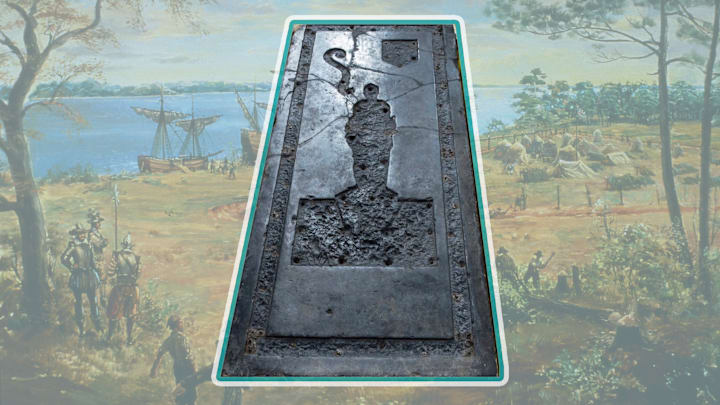The oldest surviving tombstone in the United States—a black limestone slab from 1627 that once bore the insignia of an English knight—was rediscovered at the site of Virginia’s Jamestown colony in 1901. Now, research published in the International Journal of Historical Archaeology indicates that it the stone was probably made in Belgium, imported to London, and shipped to the colony in the early 1600s.
Jamestown, the first permanent English settlement in the Americas, existed from 1607 to 1699. Due to harsh conditions, starvation, a few mass abandonments, and being set on fire during a rebellion, the government moved the colony’s capital to Williamsburg, leaving behind a wealth of scattered objects, bones, and ruins for archaeologists to piece together.
Carved depressions indicated the tombstone, which was designed to lay flat over a grave, once held emblems of a shield, an unfurled scroll, and an armored man, all indicating a British knight—and who was buried beneath was never much of a mystery. Two knighted individuals died in Jamestown: Sir Thomas West in 1618 and Sir George Yeardley in 1627. Both were one-time governors of the Virginia colony. Records from England show that, about 50 years after the tombstone was installed, Yeardley’s step-grandson, also a knight, purchased a tombstone for himself with identical inscription. Historians are pretty sure it’s Yeardley.
However, the tombstone’s material looked nothing like what was available locally. Some historians and archaeologists assumed, naturally, it had come from England. But the team behind the new study examined microfossils within the limestone and found six species of single-cell organisms, called foraminifera, that had lived 346 to 330 million years ago—only in the area that became Belgium.
The authors write that jet-black Belgian stone that resembled marble was in fashion for memorials and tombstones among the UK aristocracy. “Successful Virginia colonists who had lived in London would have been familiar with the latest English fashions and tried to replicate these in the colonies,” they suggest.
Read More fascination stories about archaeology:
